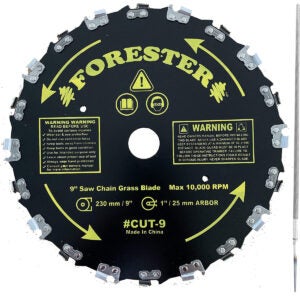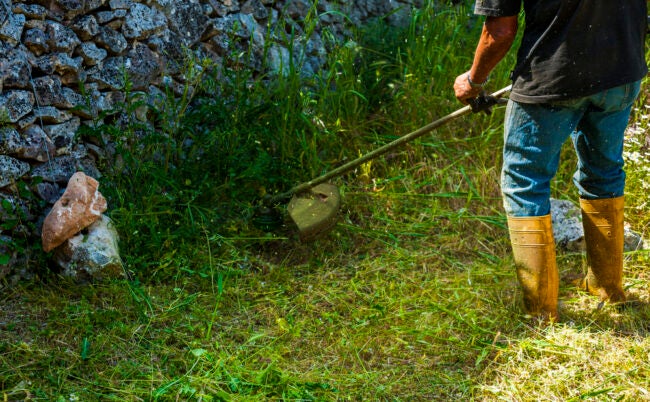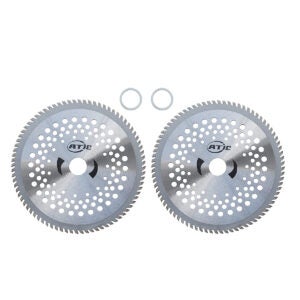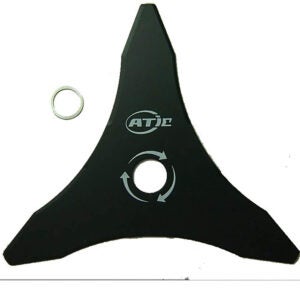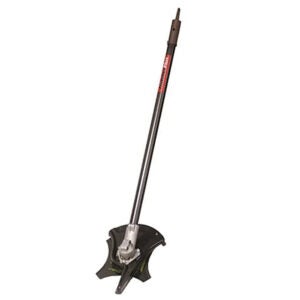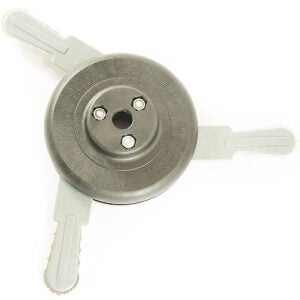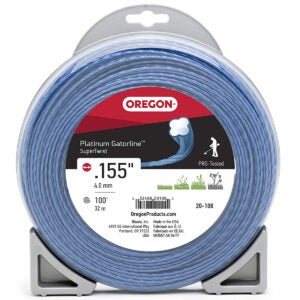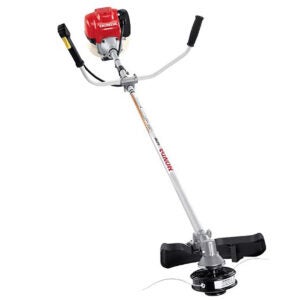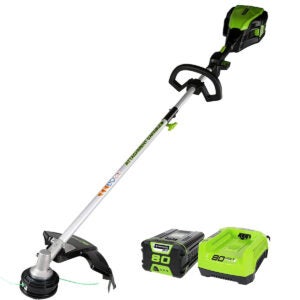Brush cutters easily grind through tall, overgrown fields, up steep hillsides, and into deep ditches where regular lawn equipment doesn’t work. When a lawnmower and weedwacker won’t cut it, a brush cutter might be the answer. Plenty of powerful tools and attachments can help you cut through heavy and overgrown weeds, vines, briars, and brambles. Read on to learn about some of the best brush cutters to clean up rough weeds and keep your lawn or acreage looking great.
- BEST OVERALL: Forester Chainsaw Tooth 9″ Brush Blade
- RUNNER-UP: ATIE 8″ 80T Carbide Tip Brush Blade
- BEST BANG FOR THE BUCK: ATIE 12″ x 3 Teeth Heavy Duty Steel Brush Blade
- BEST ATTACHMENT: TrimmerPlus BC720 Brushcutter with J-Handle
- UPGRADE TRIMMER HEAD: WW Brush Cutter
- BEST TRIMMER LINE: Oregon 20-108 Platinum Gatorline .155 Trimmer
- GAS PICK: Honda HHT35SUKAT Honda Trimmers/Brush Cutter
- ELECTRIC PICK: Greenworks 80V Cordless String Trimmer Powerhead
Before You Buy a Brush Cutter
A complete brush cutter can be an expensive, heavy-duty machine. Handheld brush cutters are heavier, more powerful, and cost two to three times more than an average weedwacker or cordless string trimmer. Depending on how heavy the brush needing cutting is, plenty of attachments and adapters can help you do the job with other tools in your shed.
High-quality string trimmers can knock down patches of dense weeds on occasion, and they see regular use grooming the yard every week or so. A good solution could be to purchase a brush-cutter head for an existing string trimmer. But if the weeds are extra heavy, the area is large, and the chore occurs frequently, it makes sense to invest in a dedicated brush cutter.
Types of Brush Cutters
Buying a new machine is a long-term investment no one should take lightly. Of course, it’s wise to buy quality tools for many years of dependable use. However, it is equally important to choose the right type of brush cutter for a property. An undersized machine wastes time, while an oversized machine wastes money and space. Read on to learn more about the different kinds of brush cutters and how they work.
String Trimmer Conversion
Instead of buying a new machine, you can simply convert a string trimmer into a brush cutter. Most string trimmers have motors between 20 and 30cc, which is not suitable for daily use as a brush cutter, but adequate for occasional heavy use. For example, use them to cut brush for a few hours, once a month.
There are two ways to convert from a string trimmer head to a rigid brush cutting head. The simplest is to use a powerhead with changeable attachments. These machines have a short drive shaft and a quick-connection system for easily switching from tool to tool in a matter of seconds. String trimmer and brush cutter attachments are just two of many attachments that powerheads can operate.
Converting a fixed string trimmer into a brush cutter requires an adapter. The adapter is unique for each brand of trimmer, but nearly all brands offer one. It takes 5 minutes or less with simple hand tools to remove the trimmer line spool and replace it with a brush-cutting head.
There are four basic types of brush cutter heads:
- Knife blades are the most common. They use a sharpened front edge to slice through weeds. Choose knife blades, either a disc knife or tri-knife, for general purpose brush cutting. They are inexpensive and long-lasting.
- Chisel knives are smaller and more aggressive than knife blades. These include the circular saw and chainsaw types. They work very well on heavier brush and small saplings but require larger engines, around 30cc and bigger, to work efficiently.
- Smasher blades, also called flails, use thin edges and high velocity to smash through vegetation. These are not suitable for heavy, woody material, but work quite well on tall weedy grass.
- Mulching blades look like knife blades, however, the blade tips bend at a nearly 90-degree angle. These are not common and are best for grinding up weeds, leaves, and branches.
Handheld
If you care for a large suburban or rural property, a handheld brush cutter might be right for you. Handheld brush cutters efficiently take down heavy weeds and thick brush areas that are not accessible by a mower. A handheld brush cutter looks like a string trimmer, only it uses a specialized brush cutting head. In fact, it is possible to retrofit a string trimmer with a brush-cutting head.
Brush-cutting heads use heavy-duty trimmer string, rigid flails, or a circular saw-type blade to cut through woody material cleanly, quickly, and efficiently. Handheld electric brush cutters and gas brush cutters with engines smaller than 40cc work well for smaller jobs, like cleaning up a vegetable garden at the end of the season. For larger areas and more aggressive cutting capability, choose a gas-powered brush cutter with an engine larger than 40cc. These heavy-duty models can cut through saplings up to 2 inches thick.
Walk-Behind
Hobby farmers and other small acreage owners choose walk-behind brush cutters for occasional maintenance of fields and pastures up to an acre. Walk-behind brush cutters have heavy-duty rotary mowers, sometimes called rough-cut mowers. These machines can cut down tall, coarse, thick grass, weeds, and weedy shrubs. Some can cut down saplings up to 2 inches in diameter or larger.
Walk-behind brush cutters are single-purpose machines, but brush cutter attachments are available for walk-behind tractors. Some lightweight models are string trimmers on wheels, but most walk-behinds are much more robust, with heavy gauge metal parts that help them grind through thick, weedy areas. They are self-propelled, with rear-mounted engines and large rear pneumatic tires. This design allows the forward mower deck to easily glide up over tall vegetation.
Tow-Behind
Farmers and managers of large-acreage properties choose tow-behind brush cutters for regular maintenance of trails, large fields, wildlife food plots, roadside areas, and utility rights-of-way. Tow-behind brush cutters, also known as brush hogs, are large rotary mowers that owners pull behind tractors or ATVs.
Some tow-behind brush cutters have their own engine that engages the blade while the user drives over the area to cut. Other tow-behinds need the tow vehicle to supply the power. They connect to the towing vehicle’s power take off (PTO) by a drive shaft that turns the mower blade.
What to Look for When Choosing the Best Brush Cutter
There are several factors to consider while shopping for a brush cutter. If shopping for handheld models, you can go with a powerful cordless electric or a long-lasting gas-powered model. Repeat use for cutting thick vines and woody brush requires more power than mowing tall grass. Ahead, learn about the factors that should drive buying decisions.
Gas vs. Electric
Handheld brush cutters come with gas or electric power; there are no electric models in the other types of brush cutters. Gas-powered cutters provide plenty of power and extended cutting time. Electric brush cutters operate quietly, keep the air clean, and eliminate cost, handling, and storage of liquid fuels.
Electric brush cutters work great for mowing down an overgrown vegetable garden at season’s end or maintaining small natural areas that are not regularly mowed. Electric is an especially good choice if the tool is only used a few times a year because it eliminates the worry over stored fuel going bad. Power and battery life both limit the use of electric brush cutters on larger properties.
Although a few 4-cycle models are available, most handheld models feature 2-cycle engines that require mixed fuel (2-cycle oil mixed into the gasoline). That adds a layer of preparation time and expense. The 4-cycle alternatives are heavier, which increases user fatigue, but adds power and pollutes less than 2-cycle models.
Motor Power
Power translates directly to working ability. A more powerful brush cutter cuts faster and more smoothly than its less-powerful competitor. Increased power helps where the conditions become more adverse, such as thicker weeds and brush or uneven terrain. When all else is equal, the more powerful machine is more capable.
Cordless electric brush cutters measure power in volts (V) and are rated between 18 and 84V. Gas-powered engines measure in cubic centimeters of displacement (cc). Handheld brush cutters range from 24 to 50cc. Handheld brush cutters with power over 56V or 35cc are considered heavy duty.
Walk-behind brush cutters and tow-behind cutters with their own engines normally list the engine size in horsepower (HP), although some manufacturers may show it in cc. There are approximately 14cc per 1 HP. You can easily convert cc to HP for an equal comparison (cc/14 = HP.) Most walk-behinds produce between 11 and 20 HP.
Tow-behind brush cutters that run via power take-off (PTO) need enough horsepower to run efficiently. Consult the tractor or ATV manufacturer’s information to learn how much horsepower a PTO supplies. The rule of thumb is that for every foot of cutter width, the PTO must supply 5 HP. A 5-foot brush cutter needs about 25 HP from the PTO.
Cutting Width
The cutting width is the width of a single pass with the brush cutter. It determines both how quickly a cutter can complete the work, and how much space the machine requires for access to the site. Handhelds range from 9 to 18 inches, walk-behinds are 24 to 26 inches, and tow-behind cutters range from 4 to 15 feet.
Wider cutters use more power, and can more easily bog down in dense vegetation. Narrow models are slower. Tow-behind brush cutters should cut wider than the width of the tractor; otherwise, the tractor will drive over some vegetation twice before the mower passes over it. Also consider the width of narrow access points the machine must pass, such as gates or closely growing trees.
Durability
Walk-behind and tow-behind brush cutters come with heavy gauge steel housing, rugged pneumatic tires, and powerful engines that hold up in rough working conditions. Handheld brush cutters are more of a gradient from light-duty string trimmers to powerful brush cutting machines. For optimal durability, use these machines to do the tasks for which they are best suited.
When converted with brush cutting heads, string trimmers with engines between 24 and 35cc are adequate for limited use on thick grass and tall weeds. Heavy-duty string trimmers with larger engines can be converted for cutting thick weeds, woody vines, and small saplings. True handheld brush cutters, with powerful 40 to 50cc engines, can extend to the cutting of thick, dense, woody vegetation.
Versatility
Tools that perform multiple tasks offer great value. Both handheld and walk-behind brush cutters are made as dedicated pieces of equipment, but most owners only use them a few times each year. Consider buying brush cutter attachments for devices that perform other lawn-care tasks.
The benefit of converting a string trimmer to a brush cutter by changing the head is that the extra head takes up virtually no storage space and extends the usefulness of existing equipment. It only takes a few minutes and simple hand tools to remove the string trimmer head from the end of the shaft and replace it with a brush-cutter head.
Handheld powerheads run lots of different tools, including string trimmers, lawn edgers, pole saws, hedge trimmers, brush cutters, and more. Powerheads feature quick-change shafts that only take a few seconds to switch between devices. Powerheads are more powerful than basic string trimmers and save the owner hundreds of dollars or more by using one engine for all needs.
Similarly, walk-behind tractors are powerheads that can do far more work than dedicated brush cutters. A walk-behind tractor lets the owner switch from brush cutter to a rototiller, snow blower, firewood splitter, pressure washer, and many other useful implements.
Universal Attachments
Anyone going the multiuse route should look closely at how the powerhead attaches to the cutter. Some large brands use proprietary attachment systems, which might work well, but tie the owner to that specific manufacturer. All future purchases also must feature the same attachment system. You can find good value in non-proprietary, or universal, attachment systems that interface with virtually all similar devices.
Our Top Picks
With all this in mind, some of the best handheld and adaptable brush-cutting products can help you clean up those overgrown corners. For a new handheld brush cutter that also can edge the driveway, check this list. If you have an excellent string trimmer and want to give it a brush-cutting upgrade, one of these products can help.
Photo: amazon.com
The Forester 9” Brush Blade works like a rotary chainsaw. Replace the head on a string trimmer with this brush cutter to clear out woody brush and coarse weeds. It can quickly cut through dense, woody brush and saplings up to 2 inches thick. The package includes a file to help keep the 20 steel cutting teeth sharp.
This brush cutter blade is durable, affordable, and easy to install. Be extra careful when working around rocks and other hard surfaces that can damage the cutting teeth. And be sure to consult the trimmer owner’s manual before buying to ensure that the blade will fit the model.
Photo: amazon.com
The ATIE 8” Carbide Tip Brush Blade is especially well suited for cutting down stands of saplings and thick, woody shrubs. With a high number of cutting teeth, it works like a circular saw on thick saplings, but it is equally as effective on coarse weeds. Carbide-hardened teeth extend the blade’s wear time—up to 10 times longer than steel. The 1-inch (20mm) arbor fits most string trimmers.
This brush-cutting blade is durable, inexpensive, and easy to install with a universal design. It has more teeth, but they might break more easily than on a blade with fewer, larger teeth. Be cautious operating this blade near rocks. As with any universal design, it makes sense to check the trimmer owner’s manual to make sure the 1-inch arbor will fit an existing machine before buying this blade.
Photo: amazon.com
The ATIE 12” x 3 Teeth Heavy Duty Steel Brush Blade is a durable steel tri-blade that is both economical and effective for cutting a wide variety of weedy and brushy material. Although not the ideal choice for large-diameter saplings, this blade handles brush measuring 1 inch in diameter and smaller. With a 1-inch (20mm) arbor, it fits most string trimmers.
This blade is larger than some fixed blades at 12 inches across and 3 mm thick. Users should sharpen the knife edges periodically for the best results. Be aware this blade is heavier than others, so consider the weight on the tool and using a shoulder strap for added support while cutting brush.
Photo: amazon.com
The TrimmerPlus BC720 Brushcutter is a universal attachment for most gas and cordless electric powerheads. The 4-tip steel blade makes quick work of tall, thick, grassy weeds and dense brush. The package includes a shoulder strap for added support and a J-bar for increased control and comfort while operating the brush cutter. The 1.65-inch inner coupler tube and 0.20-inch square drive shaft connector interface with most changeable powerheads.
This attachment is highly durable, easy to install, and a good value. Always check the powerhead owner’s manual before purchasing new attachments.
Photo: amazon.com
The WW Brush Cutter uses three moving blades to slice through heavy grass, thick weeds, and overgrown shrubs. This is a good all-purpose head for regular lawn maintenance and occasional clearing of light brush and thick, tall weeds. The replaceable metal-edged blades give a clean cut-in for a manicured lawn and clear out seedling trees and vines that occasionally grow up in hidden corners of the yard.
This brush cutter is high on value and ease of use. The molded plastic head can wear out faster than heavier duty ones, and is compatible with straight shaft trimmers only.
Photo: amazon.com
Oregon 20-108 Platinum Gatorline Trimmer Line .155-Inch features a twisted line profile for maximum cutting-edge exposure, minimum wind resistance, and excellent durability. Its hard exterior holds up well to high temperatures and impacts with hard objects. A braided line also makes less noise than other line profiles. This thick, heavy-duty trimmer line is best paired with a powerful brush cutter, greater than 35cc, for the best results.
Be careful not to add twists to the line while loading it onto the spool as that stresses the filament and can lead to early breakage. To prevent bogging down the trimmer, use this line only with strong trimmers 35cc and larger.
Photo: amazon.com
The Honda HHT35SUKAT Trimmer/Brush Cutter is a straight-shaft string trimmer with plenty of power to cut through thick brush and small saplings. The clean-burning 4-cycle gas engine runs on straight gasoline, so it requires no fuel mixing. Bicycle handlebars give ultimate comfort and control. The kit comes with a manual feed head and brush blade.
The powerful 4-cycle engine is somewhat heavy, but the shoulder strap and bicycle handlebars make it quite comfortable. This machine has plenty of power to run a heavyweight trimmer line or a rigid brush blade smoothly and efficiently. The handle configuration makes this trimmer difficult to operate as a sidewalk edger, so it might not be an all-in-one solution for everyone, but its 35cc engine can power through the brush.
Photo: amazon.com
The Greenworks 80V Cordless String Trimmer Powerhead comes with a string trimmer attachment, and adapts for lots of other functions with attachments, including a brush cutter. The 2 Ah battery provides up to 45 minutes of run time. The brushless electric motor is efficient and quiet, providing plenty of torque to cut through the same heavy weeds as its gas-powered counterparts without the noise and smell.
Users should take some care with this powerhead’s lithium-ion batteries. The batteries should be stored at about 50 percent of charge. This brush cutter is best for smaller properties due to limited run time and the need for recharging or with purchase of a second battery for extended use.
FAQs About Your New Brush Cutter
Q. How do you use a brush cutter?
Always operate the blade parallel to the ground. Because the blade spins counterclockwise, cut with the left side to avoid kickback. Use a blade with fewer than eight teeth and a long sweeping motion to cut grass. For tall, woody shrubs, use a tri-blade. Begin with the blade at waist height and lower the blade onto the material. Using a circular saw blade, only cut saplings 2 inches in diameter and smaller. Use a chainsaw for larger trees.
Always be aware of others in the area who might be harmed by flying debris. Wear hearing protection, safety glasses, work gloves, long pants, and work boots to protect yourself.
Q. How do you sharpen a brush cutter blade?
Sharpen the steel brush cutter blades with either an angle grinder or a bench grinder. If using a bench grinder, hold the blade edge at a 45-degree angle to the grinder. Press the blade steadily against the grinder as you slowly work the blade across the grinder from its center to the edge. Flip the blade and sharpen the other edge. If using an angle grinder, the process is similar, except the blade is clamped in a vice and the grinder moves across the blade.
Q. What type of engines do brush cutters use?
Handheld brush cutters use electric motors, 2-cycle gas engines, or 4-cycle gas engines. Walk-behind and tow-behind brush cutters use gas engines.
